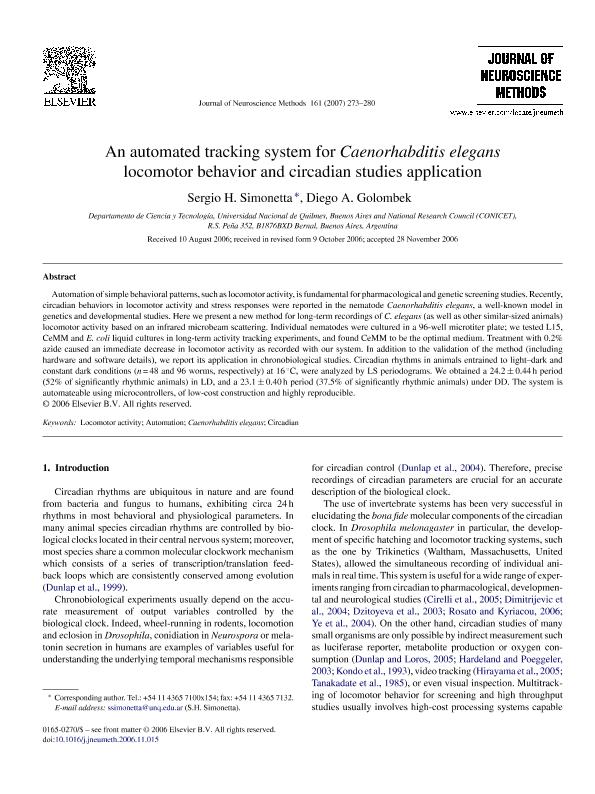Mostrar el registro sencillo del ítem
dc.contributor.author
Simonetta, Sergio Hernan

dc.contributor.author
Golombek, Diego Andrés

dc.date.available
2017-11-13T18:45:04Z
dc.date.issued
2007-01
dc.identifier.citation
Simonetta, Sergio Hernan; Golombek, Diego Andrés; An automated tracking system for Caenorhabditis elegans locomotor behavior and circadian studies application; Elsevier; Journal of Neuroscience Methods; 161; 2; 1-2007; 273-280
dc.identifier.issn
0165-0270
dc.identifier.uri
http://hdl.handle.net/11336/28061
dc.description.abstract
ADP-ribosylation of host cell proteins is a common mode of cell intoxication by pathogenic bacterial toxins. Antibodies induced by immunization with inactivated ADP-ribosylating toxins provide efficient protection in case of some secreted toxins, e.g., diphtheria and pertussis toxins. However, other ADP-ribosylating toxins, such as Salmonella SpvB toxin, are secreted directly from the Salmonella-containing vacuole into the cytosol of target cells via the SPI-2 encoded bacterial type III secretion system, and thus are inaccessible to conventional antibodies. Small-molecule ADP-ribosylation inhibitors are fraught with potential side effects caused by inhibition of endogenous ADP-ribosyltransferases. Here, we report the development of a single-domain antibody from an immunized llama that blocks the capacity of SpvB to ADP-ribosylate actin at a molar ratio of 1:1. The single-domain antibody, when expressed as an intrabody, effectively protected cells from the cytotoxic activity of a translocation-competent chimeric C2IN-C/SpvB toxin. Transfected cells were also protected against cytoskeletal alterations induced by wild-type SpvB-expressing strains of Salmonella. This proof of principle paves the way for developing new antidotes against intracellular toxins
dc.format
application/pdf
dc.language.iso
eng
dc.publisher
Elsevier

dc.rights
info:eu-repo/semantics/openAccess
dc.rights.uri
https://creativecommons.org/licenses/by-nc-sa/2.5/ar/
dc.subject
Circadian
dc.subject.classification
Biología

dc.subject.classification
Ciencias Biológicas

dc.subject.classification
CIENCIAS NATURALES Y EXACTAS

dc.subject.classification
Bioquímica y Biología Molecular

dc.subject.classification
Ciencias Biológicas

dc.subject.classification
CIENCIAS NATURALES Y EXACTAS

dc.title
An automated tracking system for Caenorhabditis elegans locomotor behavior and circadian studies application
dc.type
info:eu-repo/semantics/article
dc.type
info:ar-repo/semantics/artículo
dc.type
info:eu-repo/semantics/publishedVersion
dc.date.updated
2017-11-03T20:23:14Z
dc.identifier.eissn
1872-678X
dc.journal.volume
161
dc.journal.number
2
dc.journal.pagination
273-280
dc.journal.pais
Países Bajos

dc.journal.ciudad
Amsterdam
dc.description.fil
Fil: Simonetta, Sergio Hernan. Consejo Nacional de Investigaciones Científicas y Técnicas. Oficina de Coordinación Administrativa Parque Centenario. Instituto de Investigaciones Bioquímicas de Buenos Aires. Fundación Instituto Leloir. Instituto de Investigaciones Bioquímicas de Buenos Aires; Argentina. Universidad Nacional de Quilmes; Argentina
dc.description.fil
Fil: Golombek, Diego Andrés. Universidad Nacional de Quilmes; Argentina. Consejo Nacional de Investigaciones Científicas y Técnicas; Argentina
dc.journal.title
Journal of Neuroscience Methods

dc.relation.alternativeid
info:eu-repo/semantics/altIdentifier/url/http://www.sciencedirect.com/science/article/pii/S0165027006005760
dc.relation.alternativeid
info:eu-repo/semantics/altIdentifier/doi/https://doi.org/10.1016/j.jneumeth.2006.11.015
Archivos asociados
